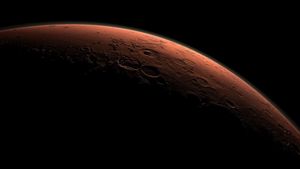JAKARTA - Two days after NASA's Double Asteroid Redirection Test (DART) spacecraft crashed into the asteroid Dimorphos, it turned out that the space rock was growing a glowing tail of debris.
A new image taken by the Southern Astrophysics Research Telescope (SOAR) in Chile, shows a bright, comet-like streak of dust emerging from the asteroid and stretching across the sky thousands of miles.
The stunning image was captured by astronomers Teddy Kareta of Arizona's Lowell Observatory and Matthew Knight of the US Naval Academy using the SOAR Telescope. From the image, visible traces of dust ejecta have been pushed by the pressure of solar radiation.
"It's amazing how clearly we were able to capture the structure and extent of the impact in the days after the impact", said Kareta in a statement quoted from ZDNet, Wednesday, October 5.
The resulting impact of DART hitting the asteroid causes dust particles and debris, ejecta that appear into space.
The SOAR image shows the new Dimorphos feature extending from the center of the image to the right edge of the image. Using Dimorphos' distance from Earth at the time the image was taken, astronomers estimated its tail length to be around 6,200 miles.
Before the collision, scientists estimated that Dimorphos itself was about 525 feet, or 160 meters wide.
Observing the ejected material could allow scientists to better define the surface properties of Dimorphos by revealing how much ejected matter collided with DART, the velocity of the ejected material, and the size of the ejected particles.
VOIR éGALEMENT:
This knowledge could eventually help space agencies like NASA protect Earth from asteroid impacts as a better understanding of asteroid structure and composition helps scientists model the best way to divert them.
"Now begins the next phase of work for the DART team as they analyze their data and observations by our team and other observers around the world who share in studying this exciting event", Knight said.
"We plan to use SOAR to monitor ejecta in the coming weeks and months."
For information, the first part of the mission was to hit the asteroid, and it was successful, the second part of the mission, observe the aftermath of the impact and see if the asteroid's path changed, this is as important as the mission goal is to prevent the asteroid from wiping out humanity in the future.
The English, Chinese, Japanese, Arabic, and French versions are automatically generated by the AI. So there may still be inaccuracies in translating, please always see Indonesian as our main language. (system supported by DigitalSiber.id)


















